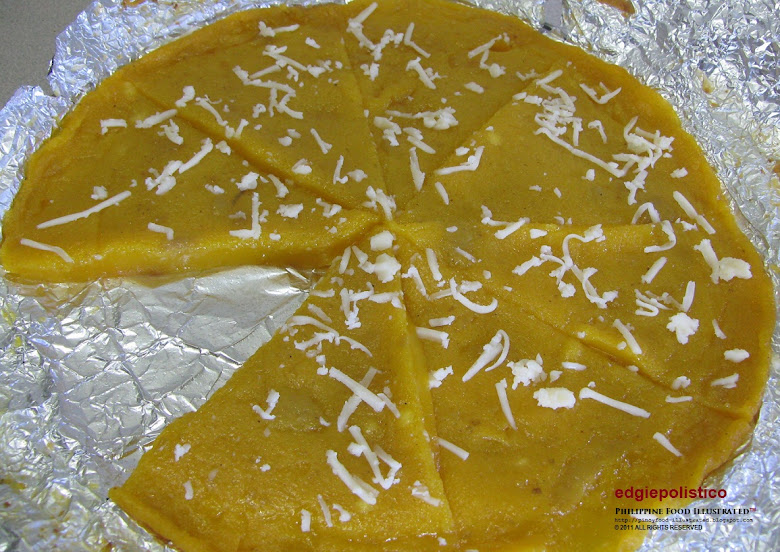bibingka royal – /bi-bíng-ka ro-yál/ Ilocano snack) [n.] flat glutinous rice cake.
A baked wide flat rice cake. Its light yellow color is from the yolks of chicken eggs used in the ingredients. Bibingka royal is brushed on top with melted butter or margarine, sprinkled with white sugar, and topped with grated cheese. The commonly used cheese is Eden cheese, cheddar cheese, or any processed filled cheese that can easily be grated into strands like those used for ensaimada bread.
When served, it is sliced like pizza and served with the optional grated coconut meat as topping right before eating.
To make bibingka royal you need at least 3 whole chicken eggs, a cup of refined sugar, 1-1/4 cups of kakang gata (coconut cream), 2 cups of galapong (ground glutinous rice batter), and 4 teaspoons of baking powder to help raise the rice batter.Before mixing all the ingredients, the oven is preheated so baking will proceed right after the mixing process.Mixing procedure start by combining sugar and half of the coconut cream in a mixing bowl and stirred well until sugar are dissolved.In another mixing bowl, the rice flour and baking powder are mixed and sifted. White sugar is added to sifted rice flour and the mixed ingredients is poured slowly into the previously prepared sugar and coconut cream mixture. The remaining half of coconut cream is added next and slowly while mixing continuously.Also in another mixing bowl, eggs are beaten until light and thick, then added with melted butter (or margarine) and mixed to blend well. The mix is pour in the previously prepared galapong batter mix.For the baking pan, sheets of fresh banana leaves are laid as linings on 2 large round flat pans. The prepared batter is poured into the pans, spread thinly and evenly. If banana leaves is unavailable, tinfoil or parchment paper will do.Baking proceed in the preheated oven. The bibingka royal is baked until it is dry and hold its shape. Toothpick test will tell that the rice cake is done.
When done, and while the rice cake is still hot, the top side is brushed with butter (or margarine) then sprinkled with white sugar and grated cheese.Bibingka royal is sliced like pizza and served with the optional siding of shredded coconut meat. You may spread coconut shreds as additional toppings right before eating the rice cake.

Bibingka royal from the food stall in Tuguegarao City's Mall of Valley.

All photos by Edgie Polistico in this blog are copyrighted. ALL RIGHTS RESERVED.
If you liked this post, share it.
Let us know your opinion on the subject. Feel free to comment in the comment section, below. We need to know what you think.
Tell us what other topics you would like us to write, share, and discuss.
For more about Filipino food, see this Philippine Food, Cooking, and Dining Dictionary. It is OPEN and FREE.
Continue to follow my blogs. You can also follow and learn more by joining us in our Facebook group. Have more bits and pieces about our kind of food, ingredients, and ways of cooking, dining, and knowing food culture across the 7,641 islands of the Philippines.
Encouragement and enthusiasm are not enough. I also need moral support, prayers, and anything else that can uplift my spirit and keep my good reasons. Keep them coming. All I know is that I am happy with what I am sharing and giving away. If you are pleased and happy with what I am doing, just smile and please share the happiness. Keep sharing and include to share the PHILIPPINE FOOD ILLUSTRATED. I feel energized when my blog becomes one of the reasons why you are happy and smiling.
Edgie Polistico







.jpg)
.jpg)













